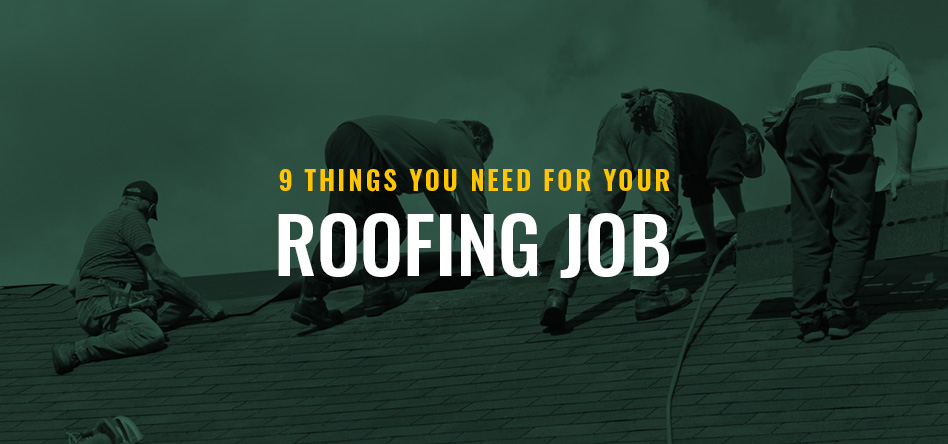
When tackling a roofing job, it is crucial to understand precisely what materials and equipment your contractor may need, so you have a complete idea of what happens during the process. A roof has various elements, from decking and underlayment to fascia board and ventilation systems. Each aspect should be discussed before any work starts or a roofing contract is signed.
Here are nine things you need for your roofing job.
Roof decking or sheathing is one of the most important parts of a roof. It is the foundation of a roofing system and is usually made from plywood or oriented strand boards (OSBs). Roof decking is a roof’s structural substrate, where all other roofing components, including shingles, are installed.
There are two main types of roof decking:
Roof decking needs to be replaced or repaired when it is damaged. Professional roof contractors will assess the condition of the decking to ensure it is safe enough to be used as the base for your new roof or shingles.
Roof underlayment is placed between your roof decking and the shingles. It acts as a second layer of defense, helping protect roofs from water damage and preventing wind from entering a house. Felt paper, ice shields, tar paper and water shields are common materials used for underlayment.
It is installed over the roof decking and should cover the entire decking area to provide adequate protection. Underlayment materials are usually sold in rolls, so take the time to accurately measure the roof to ensure there is enough material to cover it.
Rain, snow and ice can leak through unprotected roof areas, causing water damage to the structures below. To prevent this, use a leak barrier around vulnerable areas that may be prone to leaks, including the eaves, valleys, rakes, chimneys and other sections with structural penetrations. Typically, leak barriers are fiberglass-reinforced materials installed around these areas.

Shingles are one exterior material that can be used to on roofs protect the structure below, including the leak barrier and roof underlayment. Various types of shingles can be used on roofs, from asphalt to metal and slate.
The shingle material you choose will be based on your budget, design preferences and where you live. Your region’s weather patterns and climate also significantly influence your chosen material. Certain materials are better suited for dealing with weather conditions, such as rain and intense sun.
Two main types of shingles are used on a roof — starter and hip and ridge shingles. Starter shingles are installed along roof edges and eaves to help prevent shingle blow-off due to strong winds. They are typically installed first to ensure they can be secured to the roof foundation. Hip and ridge shingles are designed to fit along the hip ridges of a roof. These areas on a roof can be vulnerable to wind and rain, requiring additional protection from the elements.
A critical part of waterproofing your roof is using flashing. Flashing is a metal material, often aluminum, copper or steel, that can help prevent water leaks by creating a water-tight seal. Flashing ensures water is directed away from spots that are vulnerable to leaks, including:
Ventilation systems are essential for any roofing system. They allow air to enter and exit a roofing system properly. A balanced airflow can help prevent condensation, mold, rot and ice damming. Proper ventilation also plays a role in stabilizing internal temperatures and can help reduce energy use. Overall, ventilation can help improve the life span of a roof.
There are two types of ventilation systems to choose from when replacing your roof — active and passive. While active systems include turbine and power vents, passive systems include static and gable end vents. Both types of ventilation perform well, and your choice is usually based on preference and budget.
Ventilation must be installed before flashing and shingles.
Another vital part of any roofing job is fascia board. Fascia board is installed at the end of rafters and trusses to help protect them against water damage. The panels are usually made from wood or composite boards, and gutters get hung from here. Damaged or unsound boards will need to be replaced during a roof repair.
A nail gun and nails are the best way to install shingles and secure other elements. The type of nails used depends on the materials used on the roof, particularly the shingles. Nails may also need to meet specific building codes, so you might need several types of nails for a roofing job.
A roof ripper is the final piece of equipment needed for a roofing job. Removing an existing roof can be challenging and time-consuming, with the multiple layers requiring removal. Further, roofs are usually tightly nailed down to remain in place. A roof ripper is designed to efficiently handle these challenges, making removing parts or the whole roof considerably easier.
Every roofing job is different and may require only some of these materials and equipment. When replacing or repairing your roof, trust Total Roofing and Construction. We have over 35 years of experience repairing and replacing roofs and choose only the finest materials to ensure your roof is solid and durable to protect your home. Our teams are transparent about every step of the roofing process.
Discover more about our comprehensive roofing services and dedication to safety or contact our team for a free inspection today.